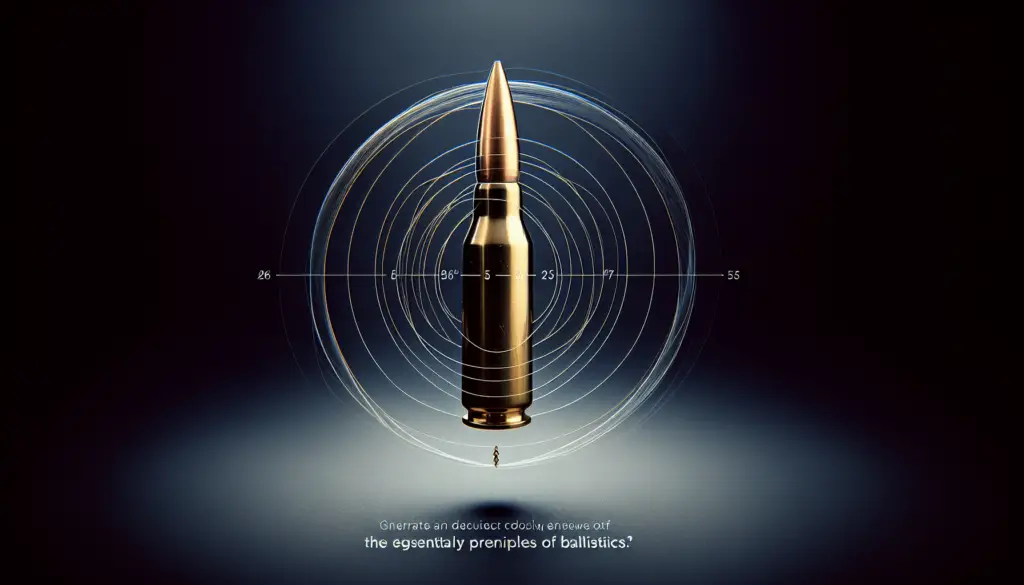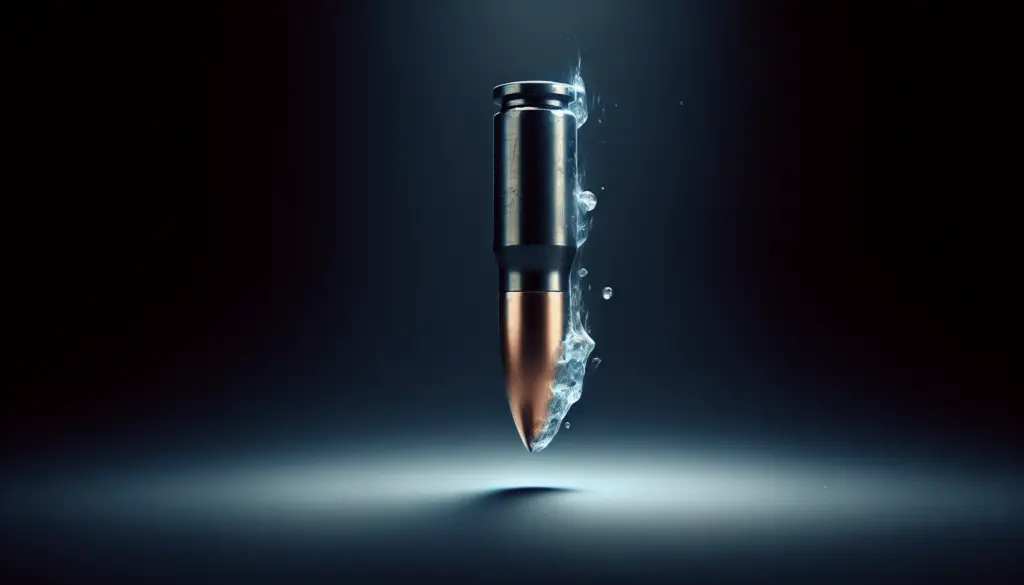Are you preparing for the unexpected? Whether it’s a natural disaster or a societal collapse, being a prepper means being prepared for anything. And one important skill for any prepper to master is understanding ballistics. In this article, we will provide you with a concise overview of the basics of ballistics: from understanding the principles of projectile motion to deciphering the key factors that affect velocity and accuracy. With this knowledge, you’ll be better equipped to make informed decisions about the types of firearms and ammunition you need to ensure your safety and survival in a post-apocalyptic world. So, grab a pen and paper, because it’s time to delve into the fascinating and essential world of ballistics!
Definition of Ballistics
Ballistics is the scientific study of the motion of projectiles, such as bullets or rockets, while they are in flight. It involves analyzing various factors that affect the trajectory, stability, and effectiveness of projectiles. There are three main branches of ballistics: internal ballistics, external ballistics, and terminal ballistics. Each branch focuses on different aspects of the projectile’s journey from the moment it is fired to the moment it reaches its target.
Internal Ballistics
The Study of Internal Ballistics
Internal ballistics is the branch of ballistics that focuses on the processes that occur inside the firearm barrel when a bullet is fired. It involves analyzing factors such as propellant burn rate, pressure, and bullet acceleration. Understanding internal ballistics is crucial for optimizing firearm performance and ensuring reliable and consistent bullet propulsion.
Factors Affecting Internal Ballistics
Various factors can influence internal ballistics. One significant factor is the rate at which the propellant burns. The speed at which the propellant burns affects the pressure buildup within the barrel and consequently impacts bullet acceleration and muzzle velocity. Other factors include the shape and weight of the bullet, the dimensions of the barrel, and the type of propellant used.
Pressure and Propellant Burn Rate
Pressure plays a vital role in internal ballistics. When the trigger is pulled, the propellant ignites, creating a rapid expansion of gases. This expansion generates pressure, which propels the bullet forward. The burn rate of the propellant determines the duration of pressure buildup and influences the rate at which the bullet gains speed. Matching the propellant burn rate to the specific bullet and firearm is essential for optimal internal ballistics.

External Ballistics
The Study of External Ballistics
External ballistics focuses on the motion of a projectile from the moment it leaves the barrel until it hits the target. It involves analyzing factors such as trajectory, drag, and the effects of environmental conditions. Understanding external ballistics is crucial for accurately predicting the bullet’s flight path and adjusting for any variables that may affect accuracy.
Factors Affecting External Ballistics
Several factors can affect external ballistics. One significant factor is the bullet’s trajectory, which is influenced by factors like muzzle velocity, gravity, and air resistance. Another crucial factor is drag, which refers to the resistance the bullet experiences as it moves through the air. Environmental conditions, such as wind speed and direction, temperature, and humidity, also play a role in external ballistics.
Trajectory and Drag
A projectile’s trajectory refers to the path it follows from the moment it leaves the barrel until it hits the target. Factors such as muzzle velocity, bullet weight, and elevation angle impact trajectory. Drag, on the other hand, refers to the resistance the bullet encounters due to air friction. Drag slows down the bullet and affects its stability. Understanding the relationship between trajectory and drag is essential for accurate long-range shooting.
Terminal Ballistics
The Study of Terminal Ballistics
Terminal ballistics focuses on the behavior of a projectile upon impact with the target. It involves analyzing factors such as bullet expansion and penetration. Understanding terminal ballistics is crucial for determining a bullet’s effectiveness in incapacitating or neutralizing a threat.
Factors Affecting Terminal Ballistics
Various factors can influence terminal ballistics. One major factor is bullet expansion upon impact. Expansion refers to the bullet’s ability to deform or expand upon hitting the target, which can increase the bullet’s diameter and enhance its stopping power. Penetration, on the other hand, refers to the bullet’s ability to penetrate through various obstacles, such as clothing or barriers, to reach vital organs or vital structures.
Bullet Expansion and Penetration
Bullet expansion and penetration are essential considerations when selecting ammunition for self-defense or hunting purposes. Different bullet designs, such as hollow point bullets or full metal jacket bullets, affect the bullet’s expansion and penetration characteristics. Hollow point bullets are designed to expand upon impact, creating a larger wound channel and increasing the chances of stopping an assailant or efficiently taking down game. On the other hand, full metal jacket bullets are designed for maximum penetration, making them suitable for situations where over-penetration is a concern.

Understanding Bullet Caliber
Definition of Caliber
Bullet caliber refers to the diameter of the bullet’s projectile. It is usually measured in inches or millimeters. Understanding bullet caliber is crucial for selecting the appropriate ammunition for a specific firearm.
Common Caliber Sizes
There are various common bullet caliber sizes, each with its own unique characteristics and applications. Some common calibers include .22LR, .380 ACP, 9mm, .45 ACP, .223 Remington, .308 Winchester, and .30-06 Springfield, among others. The choice of caliber depends on factors such as intended use, firearm compatibility, and personal preference.
Impact of Caliber on Ballistics
The caliber of a bullet can have a significant impact on its ballistics. The bullet’s diameter directly affects its weight and aerodynamic properties, which in turn influence factors such as muzzle velocity, trajectory, and terminal ballistics. Additionally, different calibers may perform differently in terms of accuracy, recoil, and penetration, among other aspects. It is essential to understand the impact of caliber on ballistics when selecting ammunition for specific purposes.
Bullet Types and their Characteristics
Full Metal Jacket (FMJ) Bullets
Full Metal Jacket (FMJ) bullets are typically used in military or target shooting purposes. These bullets have a soft lead core surrounded by a harder metal casing, usually copper. The jacket covers the entire bullet, reducing lead exposure and barrel fouling. FMJ bullets are known for their penetration abilities but may have limited expansion upon impact.
Hollow Point (HP) Bullets
Hollow Point (HP) bullets are designed for self-defense or law enforcement applications. These bullets have a cavity in the nose, allowing for controlled expansion upon impact. The expansion creates a larger wound channel, increasing the bullet’s stopping power and reducing the risk of over-penetration. Hollow point bullets are popular due to their effective terminal ballistics.
Ballistic Tip Bullets
Ballistic Tip bullets are typically used for hunting applications. They have a plastic tip attached to the bullet’s nose, which enhances the bullet’s ballistic coefficient and improves long-range performance. The plastic tip also aids in initiating expansion upon impact, resulting in rapid energy transfer and increased lethality.
Importance of Muzzle Velocity
Definition of Muzzle Velocity
Muzzle velocity refers to the velocity or speed at which a bullet leaves the firearm’s barrel when it is fired. It is typically measured in feet per second (fps) or meters per second (m/s). Muzzle velocity plays a crucial role in ballistics, as it directly influences factors such as trajectory, energy, and bullet performance.
Effects of Muzzle Velocity on Trajectory
Muzzle velocity has a significant impact on the bullet’s trajectory. A higher muzzle velocity generally results in a flatter trajectory, meaning the bullet maintains a more consistent path over longer distances. This can be advantageous for long-range shooting, as it reduces the need for adjustments when engaging targets at various distances.
Choosing the Optimal Muzzle Velocity
Selecting the optimal muzzle velocity depends on factors such as the intended purpose of the firearm, the intended range of engagement, and the specific ammunition being used. In certain scenarios, maximizing muzzle velocity may be desirable for long-range accuracy or increased terminal ballistics. In other cases, balancing muzzle velocity with factors like recoil, barrel wear, and ammunition availability may be necessary.
Factors Affecting Accuracy
Barrel Length
Barrel length can significantly impact a firearm’s accuracy. Generally, longer barrels tend to provide increased muzzle velocity and better accuracy at longer ranges. This is because longer barrels usually allow for more complete powder burn, maximizing the bullet’s potential velocity. However, excessively long barrels can negatively affect handling and may not be practical for certain applications.
Twist Rate
The twist rate of a firearm’s barrel refers to the rate at which the rifling within the barrel makes one complete revolution. The twist rate affects bullet stabilization, with different bullet weights and lengths requiring different twist rates for optimal accuracy. Using a twist rate that matches the bullet being used is crucial to ensure stability and accuracy.
Bullet Stability
Bullet stability is essential for accurate and consistent bullet flight. Stability is influenced by factors such as bullet shape, bullet weight, velocity, and the twist rate of the barrel. A stable bullet will maintain its orientation and resist tumbling or erratic flight. Understanding the factors that affect bullet stability and selecting appropriate ammunition and barrel configurations are important for achieving optimal accuracy.
Understanding Bullet Drop
Definition of Bullet Drop
Bullet drop refers to the downward curvature in a bullet’s trajectory as it travels towards a target. This curvature is caused by the influence of gravity on the bullet’s flight path. Understanding bullet drop is crucial for adjusting aiming points when engaging targets at different distances.
Influence of Gravity and Distance
Gravity has a constant and predictable effect on a projectile’s flight. As the bullet travels farther, gravity pulls it downward, causing it to drop below the line of sight. The amount of bullet drop depends on factors such as muzzle velocity, bullet weight, and the angle of elevation. The longer the distance, the more pronounced the bullet drop.
Calculating Bullet Drop
Calculating bullet drop requires knowledge of the specific firearm, bullet, and environmental conditions. Ballistic tables, ballistic calculators, or specialized reticles can assist in determining the amount of bullet drop at various distances. By knowing the bullet’s muzzle velocity and ballistic coefficient, along with the range to the target, adjustments can be made to compensate for bullet drop.
Ballistic Coefficient and its Significance
Definition of Ballistic Coefficient
Ballistic coefficient (BC) is a measure of a bullet’s ability to overcome air resistance. It is a numerical value that indicates how efficiently a bullet moves through the air. A higher BC indicates better aerodynamic performance and less drag.
Effect of Ballistic Coefficient on Flight Path
The ballistic coefficient of a bullet directly impacts its flight path. Bullets with higher BCs experience less air resistance, resulting in flatter trajectories and reduced sensitivity to environmental conditions like wind. Higher BC bullets also retain more energy downrange, making them more effective at longer distances.
Choosing High Ballistic Coefficient Bullets
Selecting bullets with higher ballistic coefficients is advantageous when shooting at longer ranges or in windy conditions. Higher BC bullets offer improved accuracy, increased energy retention, and decreased sensitivity to crosswinds. However, it is important to note that high BC bullets may require higher muzzle velocities to realize their full potential and may have different flight characteristics compared to lower BC bullets.
In conclusion, understanding the basics of ballistics is essential for firearms enthusiasts, whether for self-defense, hunting, or recreational purposes. Internal ballistics examines bullet propulsion within the barrel, external ballistics focuses on the bullet’s flight path, and terminal ballistics deals with its behavior upon impact. Factors such as caliber, bullet type, muzzle velocity, and environmental conditions all play crucial roles in determining a bullet’s trajectory, accuracy, and terminal effectiveness. By expanding our knowledge of ballistics, we can make informed decisions regarding ammunition selection, shooting techniques, and firearm customization to optimize performance and achieve our desired outcomes.
